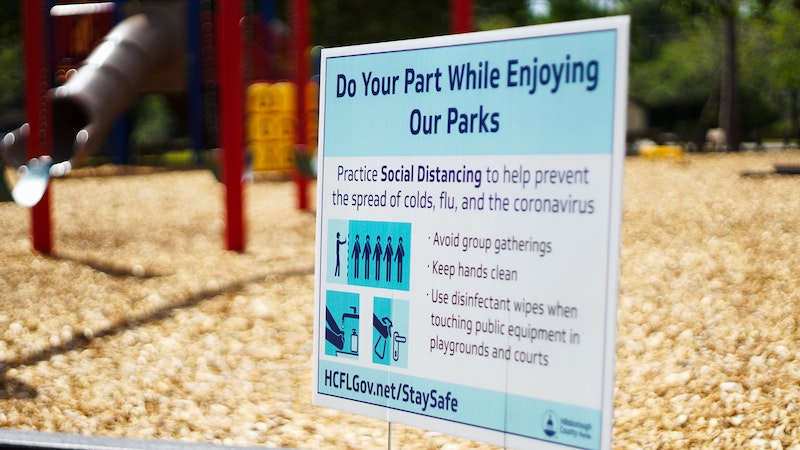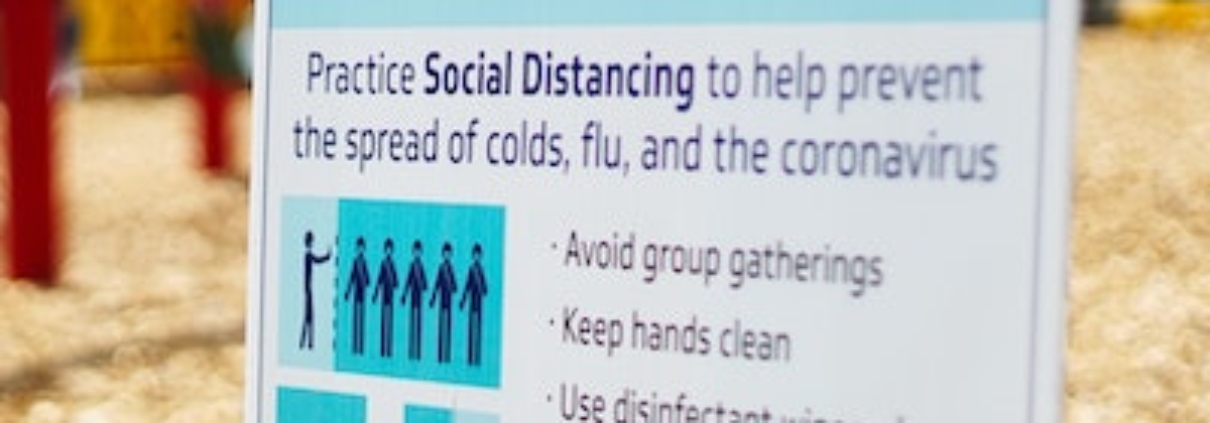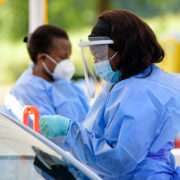Four Months into Covid-19 and 40 Years into HIV – Now, Then, and Next

Nationwide, states are loosening stay-at-home orders enacted in response to the Covid-19 pandemic. Currently, with no vaccine or treatment, risk reduction measures, including, social distancing, will remain key prevention tools to stymie community transmission of the coronavirus.
The spread of coronavirus is reminiscent of the 1980s HIV pandemic–limited information, strained public acknowledgment, and imperfect prevention and treatment strategies1. We reflect here on the role of risk reduction strategies (i.e., condom use and social distancing) in containing HIV and Covid-19.
Without meticulous contact tracing during the early days of pandemics – including HIV and Covid-19 – it is often the case that no one knows who is safe, who is infecting whom, and when. Risk reduction behaviors are the first line of defense to reduce infection and transmission. Abstinence, fidelity, reducing the number of sex partners, and condom use have been effective in controlling HIV, especially during its first two decades2. Prior to developing HIV pharmaceutical interventions [e.g., HIV pre-exposure prophylaxis (PrEP) medications for HIV negative individuals to avoid becoming positive], public health professionals have encouraged adoption of safer behaviors3-4. As we gain scientific information about Covid-19, use personal protective equipment, and develop biomedical strategies (e.g., vaccine, medications), social distancing provides a primary prevention strategy.
Social distancing for controlling Covid-19 has caused confusion. People are being asked to perform new behaviors that they may not necessarily understand or perceive positively. Questions abound. Is it strictly 6 feet? Are we staying at home for three months? What if our social circle does not want to engage in social distancing?
Back to Public Health Basics
The basic pillars of public health–correct knowledge, attitudes, behaviors, and norms–are essential to control Covid-19, as each one of us embraces social distancing and learns about its impact. Several modeling studies show the positive impact of social distancing on containing Covid-19 and Covid-19 siblings (i.e., H1N1, SARS)5-7. Clear and meaningful explanation of models contributes to our understanding of why social distancing is necessary.
Attitudes and beliefs toward social distancing are shaped by feelings. Social distancing is burdened by agonizing uncertainty, excruciating seclusion, and emotional reactions to life and death. Fever and fear are twin siblings in balancing good health and a strong economy, but education and communication can facilitate positive attitudes toward social distancing. This can empower people to take personal actions to flatten the Covid-19 pandemic curve8.
Likewise, decisions to use condoms have been wrought with emotions around trusting partners and maximizing pleasure. While many hold negative attitudes toward condom use (e.g., ruining intimacy), positive attitudes toward condoms were associated with HIV control9.
It is not easy to initiate and maintain social distancing to control Covid-19, reminiscent of the situation surrounding condom use and HIV. Public health practitioners are empowering people to feel capable of social distancing, similar to the empowering efforts for condom use, safer sex, partner communication, and negotiation of safer behaviors.
We can use social media influencers to help in modeling appropriate social distancing. Potential allies may be surprising. Kim Kardashian-West (with over 44 million followers), for example, posted an Instagram video showing her eating her food 6 feet away from others. Over the decades, we have used celebrity and edutainment to model condom use. Teens who watched a Friends episode about condoms were more likely to learn about condoms compared to those who did not watch it10. Influencers can reiterate the importance of social distancing over an extended time during predicted additional waves of Covid-19.
Testing
At an individual level, testing for the virus does not provide a risk assessment tool. Testing is best used as a clinical tool for diagnosis and clinical management. A negative test today does not ensure safety and health if one gets exposed to the virus tomorrow and gets infected and sick a few days later. At a population level, public health sero-testing, antigen testing, and surveillance enhance knowledge of the extent and range of herd immunity and hot spots, allowing for the development of population-level prevention and treatment strategies. Testing remains important in fighting infectious diseases. HIV campaigns have long emphasized that knowledge of one’s serostatus enables determining subsequent personal- and population-level prevention and treatment strategies11.
Risk Reduction Our Primary Tool as We Progress
New diseases emerge in different parts of the world without notice. Clinicians, first-responders, and affected populations need up-to-date, clear, and correct scientific and clinical information, as well as data-based protocols, personal protective equipment, and medical guidance for detecting infection, minimizing transmission, treating patients, and reducing mortality. Until medical countermeasures (e.g., vaccine, therapeutics) are available, engaging in preventive behaviors can attain the highest levels of health. While we hurry the development of vaccine and herd immunity, all while acknowledging the difficulty of social distancing in many settings and its detrimental effects on mental health and domestic abuse, social distancing is a primary tool in controlling Covid-19.
1.Padamsee TJ. Fighting an epidemic in political context: Thirty-five years of HIV/AIDS policy making in the United States. Social History of Medicine. 2018;0(0):1-28.
2. Johnson WD, Holtgrave DR, McClellan WM, Flanders WD, Hill AN, Goodman M. HIV intervention research for men who have sex with men: A 7–year update. AIDS Educ Prev. 2005;17(6):568–589.
3. Varghese B, Maher JE, Peterman TA, Branson BM, Steketee RW. Reducing the risk of sexual HIV transmission: quantifying the per-act risk for HIV on the basis of choice of partner, sex act, and condom use. Sex Transm Dis. 2002;29(1):38-43.
4. Mermin J, Fenton KA. The future of HIV prevention in the United States. JAMA. 2012 Jul 25;308(4):347-8.
5. Ahmed F, Zviedrite N, Uzicanin A. Effectiveness of workplace social distancing measures in reducing influenza transmission: A systematic review. BMC Public Health. 2018;18(1):518. https://doi.org/10.1186/s12889-018-5446-1
6. Ryu S, Gao H, Wong JY, Shiu EYC, Xiao J, Fong MW, et al. Nonpharmaceutical measures for pandemic influenza in nonhealthcare settings—international travel–related measures. Emerg Infect Dis. 2020 May [cited 2020 April 3]. https://doi.org/10.3201/eid2605.190993
7. Anderson RM, Heesterbeek H, Klinkenberg D, Hollingsworth T. How will country-based mitigation measures influence the course of the COVID-19 epidemic? The Lancet. 2020;395(10228):931–934.
8. Frieden TR, Lee CT. Identifying and interrupting superspreading events—implications for control of severe acute respiratory syndrome coronavirus 2. Emerg Infect Dis. 2020 Jun [cited 2020 Mar 24]. https://doi.org/10.3201/eid2606.200495
9. Albarracin D, Johnson BT, Fishbein, M, Muellerleile PA. Theories of reasoned action and planned behavior as models of condom use: A meta-analysis. Psychological Bulletin. 2001;127(1):142.
10. Collins RL, Elliott MN, Berry SH, Kanouse DE, Hunter SB. Entertainment Television as a Healthy Sex Educator: The Impact of Condom-Efficacy Information in an Episode of Friends. Pediatrics. 2003;112(5):1115–1121. https://doi.org/10.1542/peds.112.5.1115
11. Long E, Elias W, Semaan S, Neale S. The Role of Health Communication in Ending the HIV Epidemic. 2020 Mar 5 [cited 2020 April 2]. In: DLH Corporation. LinkedIn Blog [Internet]. Available from: https://www.linkedin.com/company/dlh-corporation/
Contributing Authors:
- Salaam Semaan, MPH, DrPH, is a public health specialist and Senior Research Scientist at DLH Corporation. She has over 35 years of experience in public health; has published over 100 publications; and previously served for 22 years in various roles in the US Centers for Disease Control and Prevention, including Deputy Associate Director for Science for the National Center for HIV/AIDS, Viral Hepatitis, STD, and TB Prevention.
- Everett L. Long, MA, PhD, is a health communicator and Director of Health Strategy and Evaluation at DLH Corporation. He develops and leads health communication efforts in collaboration with the US Centers for Disease Control and Prevention’s National Center for HIV/AIDS, Viral Hepatitis, STD, and TB Prevention.









Leave a Reply
Want to join the discussion?Feel free to contribute!